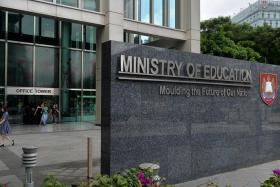More than 80 per cent of primary school teachers are women
Teaching profession in Singapore dominated by women
Pick any primary school and chances are it is led by a woman.
Of Singapore's 191 primary schools last year, three-quarters have women principals, going by the latest data from the Ministry of Education (MOE).
And more than 80 per cent of nearly 15,000 teachers in primary schools are women.
This is similar to other countries such as Britain and Australia, where the teaching profession is dominated by women.
The disparity is most pronounced in primary schools, where working with younger children is often seen as a woman's job, as some research has shown.
Overseas studies have also found that men were unsure about what kind of physical contact with children is appropriate.
Teaching is very nurturing, which may come more naturally to women.Madam Rasidah Rahim, principal of Queenstown Secondary
The numbers are less skewed when it comes to teaching older students: Women make up about 60 per cent or more of teachers in secondary schools and junior colleges here and some 50 per cent to 60 per cent of principals at those levels.
In response to queries, the MOE said it hires all educators and staff "based on their ability to do the job, regardless of gender, race or age".
"This ensures the best candidates, regardless of background, are always recruited for the position."
Educators agreed, saying that passion and commitment are the key qualities that the profession needs.
Mr Sekaran Chinna Govanden, Opera Estate Primary's head of department for physical education and co-curricular activities, said: "It is the best man for the job."
NOT SURPRISING
Educators said it is not surprising that teaching tends to attract more women, but the imbalance does not bother them.
Madam Rasidah Rahim, principal of Queenstown Secondary, said: "Teaching is very nurturing, which may come more naturally to women."
Mr Balamurugan Krishnasamy, principal of SIM International Academy, said: "Women are better inclined to provide the duty of care at the lower years, while males are better equipped to provide support for the adolescent years."
But he noted that male educators "provide a balance in the service as they can be positive role models for the male students and can provide the paternal stewardship necessary to balance the school culture".
Having a teaching workforce that is diverse - in gender, race, religion - adds value to the learning experience of students, educators said, adding that teaching is not work only for women.
Mr Lim Meng Wei, principal of Pei Chun Public School, said: "Male educators can provide more balance and share fathers' perspectives as children grow up."
Madam Rasidah said that half of her school's teachers are men.
"It is a good balance because I believe that school is a place for students to first socialise; it is a microcosm of society, as far as possible, we want it to be as close to society."
Parents said they are not bothered that most teachers are women.
Housewife Karen Chen, 35, who has a Primary 2 daughter in a girls' school, and a son going to Primary 1 next year, said: "I am okay with male or female teachers, it does not really matter...
"It is also good for the teaching force to have some balance.
"After all, my daughter can't always be in an all-girls environment as she grows up."
FOR MORE, READ THE STRAITS TIMES TODAY
Get The New Paper on your phone with the free TNP app. Download from the Apple App Store or Google Play Store now



